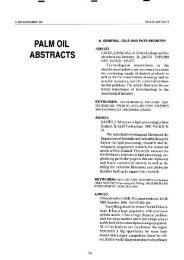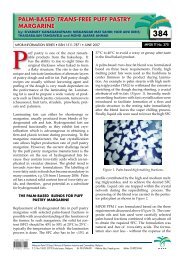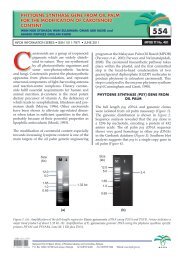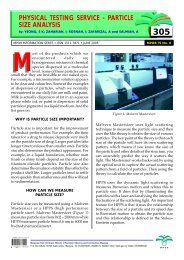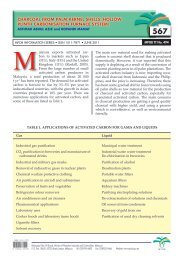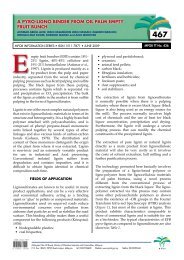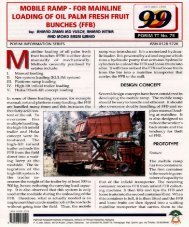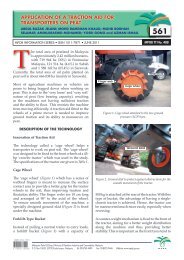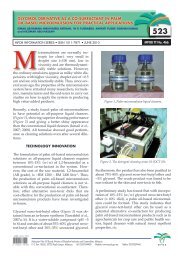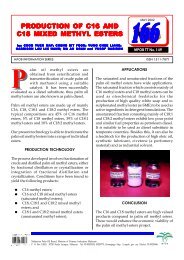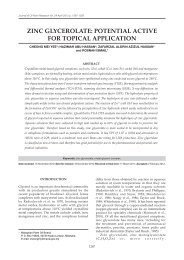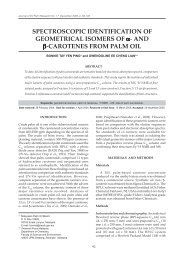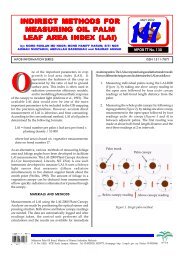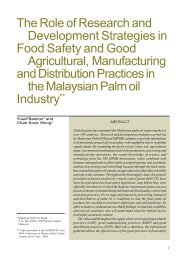Properties and Utilization of Palm Kernel Oil - PALMOILIS - MPOB
Properties and Utilization of Palm Kernel Oil - PALMOILIS - MPOB
Properties and Utilization of Palm Kernel Oil - PALMOILIS - MPOB
Create successful ePaper yourself
Turn your PDF publications into a flip-book with our unique Google optimized e-Paper software.
<strong>Properties</strong> <strong>and</strong> <strong>Utilization</strong> <strong>of</strong> <strong>Palm</strong> <strong>Kernel</strong> <strong>Oil</strong><br />
<strong>Properties</strong> <strong>and</strong> <strong>Utilization</strong> <strong>of</strong><br />
<strong>Palm</strong> <strong>Kernel</strong> <strong>Oil</strong> Pantzaris, T P* <strong>and</strong> Mohd Jaaffar Ahmad*<br />
INTRODUCTION<br />
In the world <strong>of</strong> oils <strong>and</strong> fats, the lauric oils are the aristocrats. There<br />
are very few <strong>of</strong> them, they move in their own higher price plateau <strong>and</strong><br />
they do not mix comfortably with the common oils <strong>and</strong> fats.<br />
Among the 17 major oils <strong>and</strong> fats in world trade, there are only two<br />
lauric oils, coconut oil (CNO) <strong>and</strong> palm kernel oil (PKO) (<strong>Oil</strong> World<br />
Annual, 2000) <strong>and</strong> they are called lauric because lauric acid is the major<br />
fatty acid in their composition at about 50%, while no other major oil<br />
contains more than about 1% (butter fat contains 3%). This paper is<br />
intended to give a brief outline <strong>of</strong> the properties, uses <strong>and</strong> some<br />
economic aspects <strong>of</strong> PKO.<br />
The Origin <strong>of</strong> <strong>Palm</strong> <strong>Kernel</strong> <strong>Oil</strong> (PKO)<br />
PKO is very similar to CNO in fatty acid composition <strong>and</strong> properties.<br />
The two trees also look rather similar, both are called palms but they<br />
belong to different species. The coconut palm is Cocos nucifera, while<br />
the oil palm which gives both palm oil (PO) <strong>and</strong> PKO is Elaeis<br />
guineensis (Hartley, 1988). This tree is generally believed to have<br />
originated in the jungle forests <strong>of</strong> East Africa <strong>and</strong> there is some<br />
evidence that PO was used in Egypt at the time <strong>of</strong> the Pharaohs,<br />
some 5000 years ago (Cottrell, 1991), but now its cultivation is<br />
confined mostly to Southeast Asia.<br />
The variety cultivated in nearly<br />
all the world’s plantations is the<br />
hybrid Tenera - the cross between<br />
Dura <strong>and</strong> Pisifera, which gives the<br />
highest yield <strong>of</strong> oil per hectare <strong>of</strong><br />
any crop. The great economic<br />
efficiency <strong>of</strong> the oil palm is easily<br />
seen from the following simple<br />
calculation. Soyabean cultivation<br />
in the USA for example, gives a<br />
yield <strong>of</strong> about 2.5 t <strong>of</strong> beans per<br />
hectare (1 ha = 2.47 ac), which<br />
translates into about 0.5 t <strong>of</strong> oil<br />
<strong>and</strong> 2 t <strong>of</strong> meal. Taking the<br />
monetary value <strong>of</strong> the meal at<br />
about half that <strong>of</strong> the oil, the<br />
total income to the farmer is<br />
equivalent to 1.5 t <strong>of</strong> oil. In<br />
* Malaysian <strong>Palm</strong> <strong>Oil</strong> Board (Europe)<br />
Brickendonbury, Hertford, SG13 8NL, UK.<br />
Southeast Asia, oil palms yield<br />
about 4 t <strong>of</strong> PO, plus 0.5 t <strong>of</strong><br />
PKO, plus 0.5 t <strong>of</strong> palm kernel<br />
meal, with income equivalent to<br />
more than 4.5 t <strong>of</strong> oil. Roughly<br />
for every 8 t <strong>of</strong> CPO produced at<br />
the mill, about 1 t <strong>of</strong> PKO is<br />
produced.<br />
The palm fruit looks like a<br />
plum. The outer fleshy mesocarp<br />
gives the PO, while the kernel,<br />
which is inside a hard shell, gives<br />
the PKO <strong>and</strong> it is rather strange<br />
that the two oils from the same<br />
fruit are entirely different in fatty<br />
acid composition <strong>and</strong> properties.<br />
Unfortunately, the two oils had<br />
<strong>of</strong>ten been confused by<br />
nutritionists in earlier days. In PO,<br />
most <strong>of</strong> the fatty acids are C16<br />
<strong>and</strong> higher, while in PKO, they<br />
are C14 <strong>and</strong> lower. PO has iodine<br />
value (IV) 50 minimum, while<br />
PKO has 21 maximum (Codex<br />
Alimentarius Commission, 1999).<br />
Semi-solid in temperate climates,<br />
PKO can be fractionated into solid<br />
<strong>and</strong> liquid fractions known as<br />
stearin <strong>and</strong> olein respectively.<br />
These are then physically refined,<br />
bleached <strong>and</strong> deodorized or<br />
chemically neutralized, bleached<br />
<strong>and</strong> deodorized to give the RBD<br />
<strong>and</strong> NBD grades used in the food<br />
industry. The fractionation can be<br />
done either before or after the<br />
refining, according to<br />
circumstances.<br />
PRODUCTION AND EXPORTS<br />
The oil palm only grows well in<br />
tropical climates <strong>and</strong> so all the<br />
palm kernel producing countries<br />
are in Southeast Asia, Sub-<br />
Saharan Africa <strong>and</strong> South America<br />
(<strong>Oil</strong> World Annual, 2000).<br />
Figure 1 shows the production<br />
<strong>and</strong> exports <strong>of</strong> the top four<br />
producing countries <strong>and</strong> as it may<br />
be seen, the largest producer by<br />
far is Malaysia, which currently<br />
accounts for more than 50% <strong>of</strong><br />
world production, while two<br />
countries, Malaysia <strong>and</strong> Indonesia<br />
together, account for about 80%<br />
<strong>of</strong> production <strong>and</strong> 88% <strong>of</strong><br />
exports. No other country<br />
produces more than 7% or<br />
exports more than 3% <strong>of</strong> the<br />
world total.<br />
Many people in commerce will<br />
remember that until the mid<br />
1970s, Nigeria was the world’s<br />
largest producer <strong>of</strong> palm kernels<br />
while Europe did most <strong>of</strong> the<br />
11
<strong>Palm</strong> <strong>Oil</strong> Developments 35<br />
crushing <strong>and</strong> was therefore,<br />
effectively the world’s largest PKO<br />
producer. But now all the crushing<br />
is done in the producing countries<br />
<strong>and</strong> Europe does no palm kernel<br />
crushing at all.<br />
In 1977/78, Malaysia overtook<br />
both Nigeria <strong>and</strong> Europe to<br />
become world’s biggest producer<br />
<strong>of</strong> palm kernels <strong>and</strong> <strong>of</strong> PKO.<br />
However, in the last few years,<br />
her oleochemical industry has<br />
been absorbing very large <strong>and</strong><br />
increasing quantities <strong>of</strong> the oil <strong>and</strong><br />
her lead in exports has been<br />
reduced. In fact, Indonesia’s<br />
exports were higher than<br />
Malaysia’s in 2000.<br />
With PKO <strong>and</strong> CNO having<br />
very similar properties <strong>and</strong><br />
competing with each other in the<br />
world’s markets, their relative<br />
production volumes <strong>and</strong> growth<br />
rates are important. The trade<br />
publication, <strong>Oil</strong> World gives some<br />
interesting statistics on PKO from<br />
the earliest days <strong>of</strong> its production.<br />
In 1970 for example, world PKO<br />
production was only about<br />
380 000 t or less than 20% <strong>of</strong><br />
CNO, which stood at 2.0 million<br />
tonnes. But since then, PKO being<br />
a co-product <strong>of</strong> PO has been<br />
growing at a much faster rate<br />
(6.7% annually against 1.6%),<br />
12<br />
1 600<br />
1 400<br />
1 200<br />
1 000<br />
800<br />
600<br />
400<br />
200<br />
1 385<br />
Malaysia<br />
493<br />
Indonesia<br />
721<br />
566<br />
188<br />
Nigeria<br />
Production Exports<br />
Thail<strong>and</strong><br />
Notes: world total production = 2.67 million tonnes.<br />
world total exports = 1.20 million tonnes<br />
Source: <strong>Oil</strong> World Statistics Update (9.2.2001).<br />
Figure 1. PKO: major producing <strong>and</strong> exporting countries, 2000 (’000 t).<br />
44<br />
335<br />
Others<br />
144<br />
<strong>and</strong> in 2000, it reached 2.7<br />
million tonnes or 81% <strong>of</strong> CNO.<br />
By the year 2015, the forecast is<br />
that PKO will overtake CNO<br />
with 4.6 million tonnes against<br />
4.4 million tonnes (<strong>Oil</strong> World<br />
2020, 1999).<br />
COMPOSITION AND PROPERTIES<br />
The major fatty acids in PKO are<br />
C12 (lauric acid) about 48%, C14<br />
(myristic acid) about 16% <strong>and</strong><br />
C18:1 (oleic acid) about 15%<br />
(Codex Alimentarius Commission,<br />
1999). No other fatty acid is<br />
present at more than 10% <strong>and</strong> it<br />
is this heavy preponderance <strong>of</strong><br />
lauric acid, which gives PKO <strong>and</strong><br />
CNO, their sharp melting<br />
properties, meaning hardness at<br />
room temperature combined with<br />
a low melting point (Pantzaris,<br />
2000). This is the outst<strong>and</strong>ing<br />
property <strong>of</strong> lauric oils, which<br />
determines their use in the edible<br />
field <strong>and</strong> justifies their usually<br />
higher price compared with most<br />
other oils. Because <strong>of</strong> their low<br />
unsaturation, the lauric oils are<br />
also very stable to oxidation.<br />
Table 1 shows the fatty acid<br />
composition <strong>of</strong> PKO, its similarity<br />
to CNO <strong>and</strong> their differences<br />
from PO, the co-product <strong>of</strong><br />
PKO <strong>and</strong> typical non-lauric fat.<br />
Even after full hydrogenation,<br />
the melting point <strong>of</strong> PKO does<br />
not rise much above mouth<br />
temperature <strong>and</strong> fractionation<br />
gives a stearin which is even<br />
sharper melting. Sharp melting<br />
fats leave a clean, cool,<br />
non-greasy sensation on the<br />
palate, impossible to match by<br />
any <strong>of</strong> the common non-lauric<br />
oils. Cocoa butter <strong>and</strong> palm mid<br />
fraction (PMF) come to mind,<br />
but they are much more<br />
expensive <strong>and</strong> PMF is a<br />
manufactured (fractionated)<br />
speciality fat <strong>and</strong> not a major<br />
oil in world terms.<br />
TABLE 1. FATTY ACID COMPOSITION OF PALM KERNEL,<br />
COCONUT AND PO MEAN VALUES (%)<br />
Fatty acids PKO 1 CNO 2 PO 3<br />
C6 0.3 0.4 -<br />
C8 4.2 7.3 -<br />
C10 3.7 6.6 -<br />
C12 48.7 47.8 0.2<br />
C14 15.6 18.1 1.1<br />
C16 7.5 8.9 44.1<br />
C18 1.8 2.7 4.4<br />
C18:1 14.8 6.4 39.0<br />
C18:2 2.6 1.6 10.6<br />
Others 0.1 0.1 0.75 4<br />
Notes: 1 PORIM Survey 1984, n = 68.<br />
2 Leatherhead Food RA, Surrey, UK, Survey 1990, n = 35.<br />
3 PORIM Survey <strong>of</strong> RBD PO 1989, n = 244.<br />
4 Others = C18:3 0.37%, C20:0 0.38%.
The best method for assessing<br />
the sharpness <strong>of</strong> melting <strong>of</strong> a fat<br />
is organoleptically by a trained<br />
panel or even better by an<br />
outst<strong>and</strong>ing individual. But the<br />
information so obtained cannot be<br />
communicated or stored in<br />
quantitative terms <strong>and</strong> so for that<br />
purpose, technologists rely on the<br />
solid fat content (SFC) values at<br />
various temperatures. Figure 2<br />
shows the melting behaviour in<br />
terms <strong>of</strong> SFC values <strong>of</strong> PKO, palm<br />
kernel stearin (PKS) <strong>and</strong><br />
hydrogenated PKS <strong>of</strong> melting<br />
point 35ºC (HPKS 35), together<br />
with cocoa butter (CB) <strong>and</strong> PO<br />
for comparison. The data for the<br />
graphs are average values<br />
calculated by us from Malaysian<br />
manufacturers’ specifications.<br />
Although only three basic<br />
products are made from PKO, i.e.<br />
PKO itself, palm kernel olein<br />
(PKOo) <strong>and</strong> PKS, there are also<br />
their hydrogenated <strong>and</strong> blended<br />
versions which complicate the<br />
picture considerably. The simplest<br />
way to distinguish between them<br />
is from their IV/SMP relationships<br />
<strong>and</strong> an almost complete<br />
characterization can be made by<br />
examining also their SFC pr<strong>of</strong>ile<br />
<strong>and</strong> fatty acid composition.<br />
The characteristics <strong>of</strong> PKO, PKS<br />
<strong>and</strong> PKOo are covered by<br />
Malaysian St<strong>and</strong>ards (Department<br />
<strong>of</strong> St<strong>and</strong>ards, 1987;1988a,b)<br />
which like all st<strong>and</strong>ards, give a<br />
range <strong>of</strong> values for each property.<br />
Table 2 gives the important values<br />
from those st<strong>and</strong>ards but for the<br />
fatty acid composition <strong>and</strong> SFC,<br />
for the sake <strong>of</strong> clarity, we give<br />
the mid range values rounded to<br />
the nearest 0.5. One point worth<br />
mentioning here is that the<br />
Malaysian St<strong>and</strong>ards are set from<br />
the results <strong>of</strong> large detailed<br />
surveys carried out by the <strong>Palm</strong><br />
<strong>Oil</strong> Research Institute <strong>of</strong> Malaysia<br />
(PORIM), which is now known as<br />
Malaysian <strong>Palm</strong> <strong>Oil</strong> Board (<strong>MPOB</strong>)<br />
at regular intervals, from samples<br />
taken from processing plants <strong>and</strong><br />
bulking installations throughout<br />
Malaysia. They are based<br />
therefore on a solid, scientific <strong>and</strong><br />
verifiable foundation unlike the<br />
case with most other oils.<br />
SFC (%)<br />
120<br />
100<br />
80<br />
60<br />
40<br />
20<br />
0<br />
0 10 25 20 25 30 35<br />
Temperature ºC<br />
<strong>Properties</strong> <strong>and</strong> <strong>Utilization</strong> <strong>of</strong> <strong>Palm</strong> <strong>Kernel</strong> <strong>Oil</strong><br />
Note: average values from Malaysian Manufacturers‘ Literature.<br />
Figure 2. SFC <strong>of</strong> cocoa butter, PKO product <strong>and</strong> PO.<br />
TABLE 2. MALAYSIAN STANDARDS FOR PKO,<br />
PKS AND PKOo<br />
PKS 1 PKO 2 PKOo 3<br />
MS1437:1998 MS 80:1987 MS1436:1998<br />
Iodine value (Wijs) 5.8 - 8.0 16.2 - 19.2 20.6 - 26.0<br />
SMP point (ºC) 31.3 - 33.1 25.9 - 28.0 21.8 - 26.0<br />
Fatty acid<br />
Composition % (4)<br />
6:0 0 0.5 0.5<br />
8:0 2 4.5 4.5<br />
10:0 3 3.5 4<br />
12:0 56.5 48.5 44.5<br />
14:0 22.5 15.5 14<br />
16:0 8 8 9<br />
18:0 2 2 2.5<br />
18:1 6 15 18<br />
18:2 1 2.5 3<br />
Others 0 0 0<br />
Solid fat content %<br />
(NMR) (4) 5ºC 91.5 73 63.5<br />
10ºC 90.5 67.5 55<br />
15ºC 88 55.5 38.5<br />
20ºC 81.5 40 20.5<br />
25ºC 65.5 17 6<br />
30ºC 33 0 0<br />
35ºC 0 - -<br />
Notes: 1 n = 49, 2 n = 118, 3 n = 52<br />
4 Values are mean for PKO <strong>and</strong> mid range for PKS <strong>and</strong> PKOo.<br />
These values have been rounded to the nearest 0.5. Percentages may not add up<br />
due to rounding.<br />
PO<br />
PKO<br />
CB<br />
PKS<br />
HPKS35<br />
13
<strong>Palm</strong> <strong>Oil</strong> Developments 35<br />
Also many Malaysian St<strong>and</strong>ards<br />
give not only the sample ranges<br />
but also the mean, st<strong>and</strong>ard<br />
deviation <strong>and</strong> sample size <strong>and</strong> so<br />
in this respect also, they are<br />
superior to those <strong>of</strong> most other<br />
oils, which only give range limits.<br />
It is well known from elementary<br />
statistics, that the sample range is<br />
a crude <strong>and</strong> inefficient measure <strong>of</strong><br />
variability, while with the mean<br />
<strong>and</strong> st<strong>and</strong>ard deviation, one can<br />
calculate statistical ranges,<br />
estimate the probability <strong>of</strong> any<br />
particular deviation <strong>and</strong> carry out<br />
many statistical tests.<br />
From Table 2, it may also be<br />
noted that the C12 content is<br />
highest in the stearin <strong>and</strong> lowest<br />
in the olein. The level <strong>of</strong> this fatty<br />
acid is therefore an important<br />
index <strong>of</strong> fractionation efficiency<br />
<strong>and</strong> <strong>of</strong> the quality <strong>of</strong> the product.<br />
The differences in their melting<br />
pr<strong>of</strong>iles are obvious. In practice,<br />
two qualities <strong>of</strong> PKS are made:<br />
one with IV 6-8 <strong>and</strong> SMP about<br />
31ºC-33ºC <strong>and</strong> the other<br />
hydrogenated to IV below 2 <strong>and</strong><br />
SMP about 34ºC-36ºC.<br />
Proprietary br<strong>and</strong>s may be based<br />
on blends <strong>of</strong> the two <strong>and</strong> may<br />
also contain emulsifiers for<br />
enhanced performance in<br />
particular applications, such as<br />
bloom resistance or viscosity<br />
reduction in coatings.<br />
Hydrogenated PKOo can be<br />
made to resemble the SFC pr<strong>of</strong>ile<br />
<strong>of</strong> PKO <strong>and</strong> hydrogenated PKO,<br />
but the SFC curve will not be<br />
quite as steep, the C12 content<br />
will be somewhat lower <strong>and</strong> the<br />
mouthfeel will be a little inferior.<br />
But in practice, only some very<br />
keen tasters can tell the<br />
difference. It is worth noting that<br />
with PKO (contrary to the case<br />
with PO), the most valuable<br />
product is the stearin <strong>and</strong> the<br />
least valuable one is the olein.<br />
By blending the basic PKO<br />
products (oil, olein <strong>and</strong> stearin) in<br />
different proportions,<br />
hydrogenating to different melting<br />
points, <strong>and</strong>/or interesterifying, a<br />
large number <strong>of</strong> graduated<br />
speciality products can be made<br />
for the same end-uses but<br />
<strong>of</strong>fering different performance/<br />
14<br />
cost combinations. These are the<br />
differences which distinguish the<br />
br<strong>and</strong>ed products <strong>of</strong> different<br />
manufacturers.<br />
A note on health aspects may<br />
be appropriate here. PKO is about<br />
82% saturated which is much<br />
more than the major liquid oils<br />
such as soyabean, which is only<br />
16% saturated or sunflower oil,<br />
12%, saturated (Codex<br />
Alimentarius Commission, 1999).<br />
Nutritionally, this may be thought<br />
<strong>of</strong> as a great disadvantage, but<br />
such simplistic comparisons are<br />
misleading. Lauric oils are only<br />
used in foods where a sharp<br />
melting hard fat is needed <strong>and</strong><br />
when liquid oils are hydrogenated<br />
to a similar consistency, they form<br />
not only more saturates but also<br />
trans fatty acids which some<br />
recent studies have shown may<br />
be even more objectionable in<br />
regard to blood cholesterol<br />
pr<strong>of</strong>iles than the saturated ones<br />
(Bayers, 1997; Pietinen et al.,<br />
1998). Another important<br />
consideration is that because <strong>of</strong><br />
their higher price <strong>and</strong> special<br />
properties, the lauric oils are only<br />
used where clearly necessary <strong>and</strong><br />
so only reach a very low level in<br />
our diet. In West Europe, for<br />
example, in 2000, annual per<br />
capita disappearance (use for all<br />
purposes including oleochemicals,<br />
soap <strong>and</strong> waste) for both lauric<br />
oils combined, was 3.2 kg against<br />
44 kg for the non-laurics (<strong>Oil</strong><br />
World Annual, 2000), <strong>and</strong> so the<br />
amount used for edible purposes<br />
is probably below 2.5 kg.<br />
Malaysian PKO bought from<br />
origin is usually traded according<br />
to the Malaysian Edible <strong>Oil</strong>s<br />
Manufacturers’ Association<br />
(MEOMA, 2001) or FOSFA<br />
specifications (FOSFA, 1994). The<br />
same bodies also set the trading<br />
specifications for the other major<br />
products derived from palm<br />
kernels, such as palm kernel meal,<br />
PKS, PKOo <strong>and</strong> palm kernel fatty<br />
acids. The MEOMA specifications<br />
for PKO products are shown in<br />
Table 3 <strong>and</strong> it is worth noting<br />
that the upper limit for IV is<br />
much lower than that in Codex,<br />
thus ensuring better quality.<br />
USES OF PALM KERNEL OIL<br />
(PKO)<br />
Because <strong>of</strong> their similarity in<br />
composition <strong>and</strong> properties, PKO<br />
has similar uses to CNO in both<br />
the edible <strong>and</strong> non-edible fields,<br />
but there are some small<br />
differences which are worth<br />
noting.<br />
PKO is more unsaturated <strong>and</strong><br />
so can be hydrogenated to a<br />
wider range <strong>of</strong> products for the<br />
food industry, while CNO has a<br />
somewhat greater content <strong>of</strong> the<br />
TABLE 3. MEOMA SPECIFICATIONS FOR EXPORT MARKET<br />
Crude Crude Crude<br />
PKO PKOo PKS<br />
FFA (as lauric acid) 5% max 5% max 5% max<br />
M&I 0.5% max 0.5% max 0.5% max<br />
Iodine value (Wijs) 19 max* 21 min* 8 max*<br />
RBD RBD RBD<br />
PKO PKOo PKS<br />
FFA (as lauric acid) 0.1% max 0.1% max 0.1% max<br />
M&I 0.1% max 0.1% max 0.1% max<br />
Iodine value (Wijs) 19 max* 21 max 8 max<br />
Colour (51/4” Lovibond<br />
cell) Red 1.5 max 1.5 max 1.5 max<br />
Note:*at the time <strong>of</strong> shipment.<br />
Source: MEOMA H<strong>and</strong>book 2000-2001.
more valuable shorter-chain fatty<br />
acids which make it usually a little<br />
more attractive to the oleochemical<br />
industry.<br />
PKO <strong>and</strong> its hydrogenated <strong>and</strong><br />
fractionated products are widely<br />
used either alone or in blends<br />
with other oils for the<br />
manufacture <strong>of</strong> cocoa butter<br />
substitutes <strong>and</strong> other<br />
confectionery fats, biscuit doughs<br />
<strong>and</strong> filling creams, cake icings, ice<br />
cream, imitation whipping cream,<br />
sharp-melting creaming <strong>and</strong> table<br />
margarines <strong>and</strong> many other food<br />
products.<br />
SPECIALITY FATS - COCOA<br />
BUTTER SUBSTITUTES (CBS)<br />
Speciality fats are used extensively<br />
in the food industry for<br />
applications where specific<br />
physical <strong>and</strong> chemical properties<br />
are important. For this reason, the<br />
requirements placed on these fats<br />
are different from those placed on<br />
general purpose oils. Most<br />
confectionery products for<br />
example, have a high fat content<br />
<strong>and</strong> as a result, their melting<br />
behaviour in the mouth is critical.<br />
One <strong>of</strong> the most important<br />
classes <strong>of</strong> speciality fats is that <strong>of</strong><br />
cocoa butter substitutes (CBS) for<br />
which the st<strong>and</strong>ard <strong>of</strong> comparison<br />
is cocoa butter (Pantzaris, 2000).<br />
They can be divided into two<br />
basic types, lauric <strong>and</strong> non-lauric.<br />
These fats must have not only a<br />
very steep SFC pr<strong>of</strong>ile but must<br />
also melt in the appropriate<br />
temperature range. For this<br />
property, the non-lauric type rely<br />
on a high content <strong>of</strong> trans fatty<br />
acids, while the lauric type rely on<br />
a high content <strong>of</strong> lauric acid -<br />
here we exclude the cocoa butter<br />
equivalents (CBE) which form<br />
another class with somewhat<br />
different uses. The physical<br />
properties <strong>of</strong> PKS resemble<br />
particularly closely those <strong>of</strong> cocoa<br />
butter <strong>and</strong> it is generally<br />
acknowledged that the best type<br />
<strong>of</strong> CBS as opposed to CBE, are<br />
made from this fat. Substantial<br />
quantities <strong>of</strong> PKO are therefore<br />
fractionated in Europe, USA <strong>and</strong><br />
Malaysia for this purpose.<br />
Coconut stearin on the other<br />
h<strong>and</strong>, while having exceptionally<br />
sharp melting properties <strong>and</strong><br />
mouth feel, has a lower melting<br />
point, is obtained at lower yield<br />
<strong>and</strong> is more costly to produce.<br />
Its uses therefore, are restricted to<br />
a small number <strong>of</strong> luxury<br />
products.<br />
Hydrogenated PKS <strong>of</strong> SMP<br />
about 35ºC has even higher SFC<br />
at 20ºC than cocoa butter, it<br />
gives higher contraction on<br />
cooling <strong>and</strong> tolerates better the<br />
s<strong>of</strong>tening effect <strong>of</strong> full cream milk<br />
powder. These properties make it<br />
especially suitable for hollow<br />
moulded chocolate confectionery<br />
such as Easter eggs, moulded bars<br />
<strong>and</strong> the finest biscuit creams.<br />
Hydrogenated PKO products<br />
with <strong>and</strong> without interesterification,<br />
<strong>of</strong> SMP 30ºC - 38ºC (according to<br />
climate) are used for their lower<br />
cost, but their SFC pr<strong>of</strong>ile is flatter<br />
<strong>and</strong> they are <strong>of</strong> lower quality than<br />
PKS. Nevertheless, most substitute<br />
chocolates for biscuit coating <strong>and</strong><br />
cakes are made from these fats.<br />
Even lower cost coating fats <strong>and</strong><br />
filling creams are made from<br />
hydrogenated PKOo. The SFC<br />
pr<strong>of</strong>iles <strong>of</strong> some confectionery fats<br />
are shown in Figure 2.<br />
FILLING CREAMS<br />
These products are essentially<br />
made <strong>of</strong> sugar, milk powder <strong>and</strong><br />
fat, with a fat content <strong>of</strong> about<br />
24%-28%. The finest creams for<br />
biscuits, wafer fillings <strong>and</strong> cakes<br />
are made from PKO or CNO<br />
stearins but these fats are only<br />
used in luxury br<strong>and</strong>s. In the vast<br />
majority <strong>of</strong> cases, filling creams<br />
are made from PKO, PKOo <strong>and</strong><br />
their hydrogenated versions.<br />
Important considerations here are<br />
adhesion to the biscuit shells <strong>and</strong><br />
rate <strong>of</strong> setting. Lauric fats,<br />
because <strong>of</strong> their shorter chain<br />
length, set faster than non-lauric<br />
ones <strong>and</strong> so the freshly made<br />
cream biscuits in a factory, for<br />
example, can be transported on<br />
conveyors, h<strong>and</strong>led <strong>and</strong> packed<br />
without coming apart or sheering<br />
<strong>of</strong>f-centre.<br />
<strong>Properties</strong> <strong>and</strong> <strong>Utilization</strong> <strong>of</strong> <strong>Palm</strong> <strong>Kernel</strong> <strong>Oil</strong><br />
T<strong>of</strong>fees <strong>and</strong> Caramels<br />
These two products are very<br />
similar to each other <strong>and</strong><br />
essentially consist <strong>of</strong> boiled sugar<br />
<strong>and</strong> glucose, but usually some fat<br />
is also incorporated in their<br />
formulations in order to adjust<br />
their texture, hardness, chewiness<br />
<strong>and</strong> richness <strong>of</strong> taste. A further<br />
advantage <strong>of</strong> fat incorporation is<br />
that it delays sugar inversion<br />
during storage <strong>and</strong> reduces<br />
stickiness on wrapping materials<br />
(Pantzaris, 2000).<br />
The fats used are usually based<br />
on hydrogenated PKO (HPKO) or<br />
hydrogenated PKOo (HPKOo),<br />
because <strong>of</strong> their sharp melting<br />
properties <strong>and</strong> long shelf-life.<br />
Incorporating some PKS in them<br />
gives even better eating quality.<br />
Ice-Cream<br />
PKO <strong>and</strong> CNO are the best<br />
fats for non-dairy ice cream<br />
because <strong>of</strong> their combination <strong>of</strong><br />
high SFC at about 0ºC, low<br />
melting point <strong>and</strong> perfectly bl<strong>and</strong><br />
taste (Pantzaris, 2000).<br />
Surprisingly, ice cream is<br />
particularly sensitive to any flavour<br />
notes from the fat.<br />
Similarly, CNO <strong>and</strong> PKOo are<br />
used to make the chocolate for<br />
dipping ice cream. This chocolate<br />
is made by diluting st<strong>and</strong>ard<br />
chocolate with extra fat. The<br />
product must have low viscosity<br />
<strong>and</strong> yet set quickly so that the ice<br />
cream does not melt too much<br />
<strong>and</strong> drip into it. The operation is<br />
quite finely balanced.<br />
Imitation Whipping Creams<br />
This product is very critical in<br />
its fat requirement because it<br />
must whip quickly to a high<br />
volume <strong>and</strong> hold that volume for<br />
many hours with as little<br />
shrinkage <strong>and</strong> seepage as possible.<br />
Pure HPKO, PKS <strong>and</strong> their blends<br />
are the st<strong>and</strong>ard fats used.<br />
see p.19<br />
15
from p.15<br />
Non-dairy Creamers<br />
(c<strong>of</strong>fee whiteners)<br />
These powder products have a<br />
very large surface area in relation<br />
to their mass <strong>and</strong> yet are required<br />
to have long shelf-lives.<br />
Hydrogenated PKO <strong>and</strong> CNO are<br />
the most suitable fats because<br />
when reduced to an IV below<br />
about 2, they have extremely<br />
high oxidative stability <strong>and</strong> yet<br />
reasonably low melting point.<br />
Most <strong>of</strong> the leading international<br />
br<strong>and</strong>s <strong>of</strong> non-dairy creamers are<br />
made with HPKO.<br />
Filled Milk<br />
This is a widely used product in<br />
which the milkfat has been<br />
replaced by vegetable fat. In<br />
many respects, it is similar to<br />
non-dairy creamers, but with a<br />
lower fat content. CNO has been<br />
the traditional fat in this<br />
application, because <strong>of</strong> its high<br />
stability, low melting point <strong>and</strong><br />
bl<strong>and</strong> taste but increasingly now,<br />
it is being replaced by PKO or<br />
hydrogenated PKOo, when there<br />
is a price advantage.<br />
Hydrogenated PO is also used<br />
for lower cost.<br />
Margarines<br />
Special margarines which whip<br />
easily to produce light filling<br />
creams for use in layer cakes <strong>and</strong><br />
other bakery products rely on<br />
high levels <strong>of</strong> lauric fat to confer<br />
good eating <strong>and</strong> h<strong>and</strong>ling<br />
properties.<br />
Other general purpose <strong>and</strong><br />
table margarines <strong>of</strong>ten contain<br />
PKO or hydrogenated PKO to<br />
give them quick melting properties<br />
or compensate for the use <strong>of</strong><br />
other higher melting fats or for<br />
the absence <strong>of</strong> trans fats which<br />
are also sharp melting.<br />
A recent study <strong>of</strong> table<br />
margarines in Spain has found<br />
that those based on higher levels<br />
<strong>of</strong> lauric <strong>and</strong> palm fats had much<br />
lower trans fatty acid <strong>and</strong> higher<br />
polyunsaturated content than the<br />
other margarines made from<br />
blends <strong>of</strong> partially hydrogenated<br />
<strong>and</strong> non-hydrogenated seed oils<br />
(Alonso et al., 2000).<br />
Medium Chain Triglycerides<br />
(MCT)<br />
This is an important speciality<br />
product made from lauric oils or<br />
rather from the fatty acids <strong>of</strong><br />
these oils. They are usually<br />
referred to as MCT <strong>and</strong> are based<br />
on C8 - C10 chain lengths. Their<br />
shorter chains <strong>and</strong> full saturation<br />
give them very low viscosity <strong>and</strong><br />
high oxidative stability. But their<br />
main use is in hospitals, etc., for<br />
cases where the patients cannot<br />
metabolize conventional fats in<br />
the usual way. MCT are<br />
metabolized by a different<br />
pathway. A certain amount <strong>of</strong> fat<br />
is essential in human diets to<br />
carry the fat soluble vitamins <strong>and</strong><br />
synthesize the prostagl<strong>and</strong>ins, etc.,<br />
<strong>and</strong> MCT meet the first <strong>of</strong> these<br />
functions at least.<br />
CNO contains much more MCT<br />
than PKO. The usual method <strong>of</strong><br />
manufacture is to start with the<br />
lauric acid oils or the distilled C8<br />
<strong>and</strong> C10 saturated fatty acids <strong>and</strong><br />
esterify with glycerol. The MCT<br />
content can then be further<br />
concentrated by further<br />
processing.<br />
NON-FOOD USES<br />
Most <strong>of</strong> the PKO from world<br />
production is <strong>of</strong> course used for<br />
food, but the non-food uses are<br />
very substantial <strong>and</strong> becoming <strong>of</strong><br />
increasing importance because, on<br />
the whole, these products are<br />
further downstream <strong>and</strong> <strong>of</strong>fer<br />
greater added value to the<br />
manufacturers <strong>and</strong> greater<br />
opportunities for local<br />
employment in the producing<br />
countries. Also, their world<br />
markets are easier to penetrate<br />
since they do not depend on<br />
national tastes <strong>and</strong> subjective<br />
preferences.<br />
<strong>Properties</strong> <strong>and</strong> <strong>Utilization</strong> <strong>of</strong> <strong>Palm</strong> <strong>Kernel</strong> <strong>Oil</strong><br />
Suppositories<br />
This is another important<br />
pharmaceutical use <strong>of</strong> PKO<br />
products. Suppositories are<br />
designed to supply various<br />
medicines through the rectum,<br />
where supplying by mouth or by<br />
injection is for some reason, less<br />
acceptable.<br />
The most appropriate fats are<br />
hard, sharp melting ones, SMP<br />
35ºC-37ºC <strong>and</strong> cocoa butter has<br />
been the traditional one.<br />
However, CBS, like HPKS or<br />
HPKO, <strong>of</strong>fer advantages in ease<br />
<strong>of</strong> production, less discolouration<br />
over time, have no need for<br />
tempering, their consistency is<br />
more easily adjusted <strong>and</strong> also<br />
have lower cost. Cocoa butter<br />
does not <strong>of</strong>fer any extra<br />
advantages <strong>and</strong> where it is still<br />
used, it is because <strong>of</strong> tradition, or<br />
the difficulty <strong>and</strong> expense <strong>of</strong><br />
obtaining licence for a new<br />
product.<br />
However, the main non-food<br />
uses <strong>of</strong> lauric oils are in soap <strong>and</strong><br />
certain oleochemicals, such as:<br />
fatty acids, methyl esters <strong>and</strong><br />
fatty alcohols. Strictly speaking,<br />
soap itself is also an oleochemical<br />
<strong>and</strong> the oldest one, but it is<br />
usually classed separately since it<br />
has an entirely different<br />
appearance, uses <strong>and</strong> market.<br />
Soap<br />
Many different oils can be used<br />
for soap making but a proportion<br />
<strong>of</strong> lauric oil is indispensable. Good<br />
soap must contain at least 15%<br />
lauric oil for quick lathering.<br />
Soap in West Europe <strong>and</strong> USA<br />
typically contains 20%-25% PKO<br />
or CNO, while soap made for use<br />
in sea water is based on virtually<br />
100% lauric oil. Lauric oils confer<br />
hardness, combined with good<br />
solubility (which in other fats are<br />
inversely correlated), quick<br />
lathering <strong>and</strong> a feel <strong>of</strong> quality to<br />
the soap. Also their higher<br />
resistance to oxidation helps delay<br />
rancidity <strong>and</strong> deterioration <strong>of</strong> the<br />
perfume, which is a very major<br />
consideration in toilet soap.<br />
19
<strong>Palm</strong> <strong>Oil</strong> Developments 35<br />
CNO, being older, has been<br />
the traditional fat for this<br />
application, but now PKO is used<br />
interchangeably with CNO<br />
according to price <strong>and</strong> in fact<br />
with some subtle advantages.<br />
Table 4 gives a brief summary <strong>of</strong><br />
the soap making properties <strong>of</strong><br />
some fats <strong>and</strong> <strong>of</strong> course, these<br />
properties follow from their fatty<br />
acid composition. <strong>Palm</strong>itic (16:0)<br />
<strong>and</strong> stearic (18:0) acids confer<br />
hardness, lower solubility <strong>and</strong><br />
slower though more persistent<br />
lather. The saturated shorter chain<br />
C12 <strong>and</strong> lower fatty acids confer<br />
hardness with greater solubility<br />
<strong>and</strong> quicker, though less persistent<br />
lather. However, the very shortchain<br />
fatty acids C10 <strong>and</strong> below<br />
can also be irritating to sensitive<br />
skins <strong>and</strong> so their level must be<br />
kept very low. This is the<br />
advantage <strong>of</strong> PKO over CNO,<br />
20<br />
which was referred to earlier.<br />
Super-fatting the soap will also<br />
reduce any tendency to skin<br />
irritation.<br />
Myristic acid (C14:0) is usually<br />
considered the ideal soap making<br />
fatty acid in its combination <strong>of</strong><br />
properties, but it is not very<br />
plentiful in nature. Nevertheless,<br />
PKO <strong>and</strong> CNO contain more <strong>of</strong> it<br />
than any other <strong>of</strong> the major oils<br />
<strong>and</strong> fats <strong>and</strong> it may be worth<br />
noting that a blend <strong>of</strong> 50/50<br />
C12/C16 fatty acids has an<br />
average molecular weight equal<br />
to C14.<br />
Of particular interest to<br />
commercial soap makers is PKOo<br />
which has very similar fatty acid<br />
composition to PKO <strong>and</strong> yet<br />
always sells at a discount to it.<br />
<strong>MPOB</strong> experiments as well as<br />
industrial experience have now<br />
confirmed that it can replace PKO<br />
TABLE 4. SOAP MAKING PROPERTIES OF DIFFERENT OILS AND FATS *<br />
Colour<br />
Fats <strong>and</strong> oils <strong>of</strong> the Consistency Lathering Cleansing Action<br />
resulting <strong>of</strong> soap qualities properties on skin Application<br />
soap<br />
PKO Very white Very hard Quick but Fair Biting Toilet<br />
non-lasting Household<br />
Shaving<br />
CNO Very White Very hard Quick but Fair Biting Toilet<br />
non-lasting Household<br />
Shaving<br />
POs Pale yellow Hard Slow but Very good No action Laundry &<br />
lasting household<br />
RBD PO White Fairly hard Slow but Very good No action Toilet &<br />
lasting good quality<br />
laundry<br />
Tallow White Fairly hard Slow but Very good No action Toilet &<br />
lasting good quality<br />
laundry<br />
Cottonseed or Buff to Medium Quick & Good No action Household &<br />
Groundnut white s<strong>of</strong>t medium lasting laundry<br />
Rosin Brown S<strong>of</strong>t & Thin & Medium No action Household &<br />
sticky greasy toilet<br />
Note: *amended Table from Iftikhar, A (1987). PORIM Technology No. 2:8 pp.<br />
without any noticeable difference.<br />
Malaysia has a soap making<br />
capacity <strong>of</strong> about 230 000 t<br />
annually which is exported mainly<br />
in the form <strong>of</strong> noodles. This<br />
product <strong>of</strong>fers some very useful<br />
advantages to soap producers<br />
especially those contemplating<br />
exp<strong>and</strong>ing their present plants or<br />
entering production for the first<br />
time with limited capital<br />
availability.<br />
Production <strong>of</strong> soap from oils<br />
<strong>and</strong> fats or even from fatty acids,<br />
requires large capital expenditure<br />
on heavy plant such as steam<br />
boilers boiling kettles, storage<br />
tanks for oils <strong>and</strong> caustic soda,<br />
glycerine concentration plant,<br />
etc. Production <strong>of</strong> soap from<br />
noodles on the other h<strong>and</strong>, only<br />
requires simple mixing with colour<br />
<strong>and</strong> perfume, tableting <strong>and</strong><br />
wrapping.
Besides soap made from oils<br />
<strong>and</strong> fats (triglycerides), another<br />
major process uses the fatty acids<br />
<strong>of</strong> the same fats. This route <strong>of</strong>fers<br />
the advantages <strong>of</strong> greater<br />
simplicity, lower capital<br />
expenditure <strong>and</strong> better control <strong>of</strong><br />
the quality <strong>of</strong> the feedstocks.<br />
However, fatty acids are corrosive,<br />
more difficult to transport <strong>and</strong><br />
store in bulk, have a tendency to<br />
discolour <strong>and</strong> they do not yield<br />
any glycerine.<br />
Yet another process is one<br />
utilizing the methyl esters <strong>of</strong> the<br />
fatty acids, which overcomes most<br />
<strong>of</strong> the problems associated with<br />
fatty acids. It has found particular<br />
favour in Japan where very white<br />
soap is in dem<strong>and</strong> <strong>and</strong> deserves<br />
better attention worldwide.<br />
Ultimately, for soap makers, the<br />
choice <strong>of</strong> process will depend on<br />
the scale <strong>of</strong> operation, availability<br />
<strong>and</strong> quality <strong>of</strong> raw materials, their<br />
relative cost, market for the<br />
by-products <strong>and</strong> capital<br />
expenditure envisaged. But in the<br />
end, the soap must contain the<br />
appropriate level <strong>of</strong> PKO or CNO<br />
fatty acids, whatever the process<br />
employed.<br />
Oleochemicals<br />
The modern oleochemical<br />
products based on fatty acids <strong>and</strong><br />
their derivatives are <strong>of</strong> increasing<br />
importance to the oil producing<br />
countries because they provide an<br />
additional outlet with higher<br />
added value. And they are also <strong>of</strong><br />
increasing importance to the<br />
Western countries because they<br />
are made from renewable natural<br />
sources <strong>and</strong> are more easily<br />
biodegradable than those derived<br />
from petroleum (Salmiah, 1995).<br />
In Malaysia for example, in 2000,<br />
about 812 000 t or nearly 60%<br />
<strong>of</strong> her PKO production was used<br />
internally, mostly for<br />
oleochemicals.<br />
The basic oleochemical products<br />
made from lauric fats, are the<br />
short <strong>and</strong> medium chain fatty<br />
acids (C8 - C14), their methyl<br />
esters <strong>and</strong> the fatty alcohols<br />
which are made by hydrogenation<br />
<strong>of</strong> the esters (Salmiah et al.,<br />
1998). PKO <strong>and</strong> CNO compete<br />
directly in this area where they<br />
are even more interchangeable<br />
than they are in the edible field.<br />
In recent years, there has been a<br />
tremendous shift in oleochemical<br />
production from the West to<br />
Southeast Asia <strong>and</strong> from CNO to<br />
PKO. From published statistics, for<br />
example, it is evident that since<br />
1990, nearly all the world<br />
expansion has been in Southeast<br />
Asia which has moved from 12%<br />
<strong>of</strong> the world total to 35%<br />
currently (Table 5).<br />
In the Philippines, a large<br />
oleochemical industry is based on<br />
CNO while in Malaysia, there is<br />
even greater production based on<br />
PKO. In Malaysia, the growth <strong>of</strong><br />
the oleochemical industry has<br />
been spectacular. The first<br />
oleochemical plant was built in<br />
1979, producing PK fatty acids<br />
<strong>and</strong> glycerol. Currently, the<br />
country has an annual production<br />
capacity <strong>of</strong> 650 000 t <strong>of</strong> fatty<br />
acids, 175 000 t <strong>of</strong> methyl esters,<br />
175 000 t <strong>of</strong> fatty alcohols,<br />
120 000 t <strong>of</strong> glycerine <strong>and</strong><br />
230 000 t <strong>of</strong> soap (Yus<strong>of</strong>, 1999).<br />
PRICE RELATIONSHIPS<br />
The distinction between pure<br />
science <strong>and</strong> technology is not very<br />
clear <strong>and</strong> has been defined in<br />
various ways but the main<br />
difference is probably that the<br />
latter is concerned with making<br />
products that must be sold<br />
against competition. Technologists<br />
<strong>Properties</strong> <strong>and</strong> <strong>Utilization</strong> <strong>of</strong> <strong>Palm</strong> <strong>Kernel</strong> <strong>Oil</strong><br />
therefore, especially those in<br />
research <strong>and</strong> development, must<br />
have some idea <strong>of</strong> prices <strong>and</strong><br />
their trends or risk being left<br />
groping in the dark. The<br />
following points are therefore<br />
worth noting.<br />
In view <strong>of</strong> the similarity <strong>of</strong><br />
PKO to CNO in respect <strong>of</strong><br />
composition, properties <strong>and</strong> uses,<br />
one should not be surprised to<br />
find similarity in prices <strong>and</strong><br />
fluctuations in the same direction.<br />
Recently, we examined the<br />
relationship between their prices<br />
over the last 12 years (1989 -<br />
2000) <strong>and</strong> we found that over<br />
that period, PKO was at an<br />
average discount <strong>of</strong> US $9 t -1 .<br />
The price relationship was linear<br />
with a very highly significant<br />
correlation coefficient (r = 0.986,<br />
p < 0.001) (Figure 3).<br />
The equation linking the two<br />
prices was:<br />
PKO = 0.998 CNO - 7.65<br />
About 97% <strong>of</strong> the price<br />
variation <strong>of</strong> PKO can be explained<br />
by that <strong>of</strong> CNO.<br />
As regards their price trends,<br />
both have been rising. That for<br />
PKO by US$ 21.5 t -1 annually <strong>and</strong><br />
that for CNO was US$ 20.3 t -1<br />
annually, but the difference is not<br />
statistically significant.<br />
FUTURE DEVELOPMENTS<br />
The <strong>MPOB</strong>, has been carrying out<br />
continuous research to widen the<br />
very limited gene pool <strong>of</strong> the<br />
current oil palm planting material,<br />
TABLE 5. PRODUCTION OF BASIC OLEOCHEMICALS<br />
IN SOUTHEAST ASIA AND THE WORLD (’000 t)<br />
Country/Region 1990 1995 2000E<br />
Malaysia 262.2 807.0 1 200.0<br />
Philippines 172.5 285.0 480.0<br />
Indonesia 62.7 199.5 400.0<br />
Thail<strong>and</strong> 11.0 22.0 44.0<br />
Southeast Asia 508.4 1 313.5 2 124.0<br />
Others 3 908.6 3 950.5 3 974.0<br />
World production 4 417.0 5 264.0 6 098.0<br />
Southeast Asia % <strong>of</strong> world 12% 25% 35%<br />
Source: <strong>MPOB</strong>.<br />
Note: E = estimated.<br />
21
<strong>Palm</strong> <strong>Oil</strong> Developments 35<br />
22<br />
PKO, US$ t -1<br />
800<br />
700<br />
600<br />
500<br />
400<br />
300<br />
TABLE 6. RANGE IN THE CHARACTERISTICS OF Dura MOTHER<br />
PALMS WITH HIGH KERNEL CONTENT<br />
Range<br />
Fresh fruit bunches (kg palm -1 yr -1 ) 162.2 - 197.7<br />
Bunch number (No. palm -1 yr -1 ) 8 - 24<br />
Average bunch weight (kg palm -1 yr -1 ) 7.4 - 22.8<br />
<strong>Kernel</strong> to fruit (%) 16.2 - 20.4<br />
<strong>Kernel</strong> to bunch (%) 10.53 - 13.26<br />
<strong>Oil</strong> per palm per year (kg) 21.9 - 33.2<br />
Source: <strong>MPOB</strong>.<br />
300 400 500 600 700 800<br />
CNO, US$ t -1<br />
Equation: PKO = 0.998, CNO = -7.65<br />
r 2 = 0.973, P< 0.001, (n = 12).<br />
Figure 3. PKO <strong>and</strong> CNO: relationship between their average annual<br />
prices, 1989-2000, cif Rotterdam.<br />
which restricts severely the degree<br />
<strong>of</strong> improvement which can be<br />
achieved with them. Germplasm<br />
was collected periodically from the<br />
regions <strong>of</strong> Africa where the tree<br />
originated, aiming to find suitable<br />
genetic material with which to<br />
enrich the current breeding<br />
population. The first collection was<br />
planted in 1976 <strong>and</strong> after<br />
extensive evaluation, two series <strong>of</strong><br />
elite planting materials were<br />
introduced to the industry. These<br />
are known as PORIM Series 1<br />
<strong>and</strong> PORIM Series 2 <strong>and</strong> <strong>of</strong>fer<br />
greater yield <strong>of</strong> oil <strong>and</strong> different<br />
fatty acid composition (Jalani <strong>and</strong><br />
Mohd Jaafar, 1999). Another new<br />
elite planting material, PORIM<br />
Series 3, has now been<br />
developed which gives more than<br />
10% kernel content per bunch,<br />
compared with 5% from the<br />
usual palms (Table 6). It is<br />
expected that these new palms<br />
will put the Malaysian industry in<br />
a good position to meet the<br />
increasing dem<strong>and</strong> for lauric oils<br />
in food, soap <strong>and</strong> oleochemicals.<br />
PKO world production is<br />
currently below that <strong>of</strong> CNO by<br />
about one-third, but being a<br />
co-product <strong>of</strong> PO, its rate <strong>of</strong><br />
growth is much higher <strong>and</strong> our<br />
forecast is that in the working<br />
lifetime <strong>of</strong> most readers <strong>of</strong> this<br />
paper, it will become the major<br />
lauric oil at just about the same<br />
time when PO will become the<br />
major non-lauric oil.<br />
ACKNOWLEDGEMENT<br />
Substantially the same article was<br />
published in the February 2001<br />
issue <strong>of</strong> INFORM, <strong>and</strong> AOCS<br />
Press publication. We are grateful<br />
for their permission to reproduce<br />
it here.<br />
REFERENCES<br />
ALONSO, L; FRAGA, M J <strong>and</strong><br />
JUAREZ, M (2000). Determination<br />
<strong>of</strong> trans fatty acids <strong>and</strong> fatty acid<br />
pr<strong>of</strong>iles in margarines marketed in<br />
Spain. J. Amer. <strong>Oil</strong> Chem. Soc., 77:<br />
131-135.<br />
BAYERS, T (1997). Hardened fats,<br />
hardened arteries. New Engl<strong>and</strong><br />
Journal <strong>of</strong> Medicine, 337: 1544-<br />
1545.<br />
CODEX ALIMENTARIUS<br />
COMMISSION (1999). Report <strong>of</strong><br />
the Sixteenth Session <strong>of</strong> the Codex<br />
Committee on Fats <strong>and</strong> <strong>Oil</strong>s.<br />
Alinorm 99/17: Appendix II.<br />
Rome, Italy.<br />
COTTRELL, R C (1991). Nutritional<br />
aspects <strong>of</strong> palm oil. Am.J.Clin.<br />
Nutr., 53: 989S-1009S.<br />
de MAN, J M <strong>and</strong> de MAN, L<br />
(1994). Speciality Fats Based on<br />
<strong>Palm</strong> <strong>Oil</strong> <strong>and</strong> <strong>Palm</strong> <strong>Kernel</strong> <strong>Oil</strong>.<br />
MPOPC, Kuala Lumpur. 16 pp.<br />
DEPARTMENT OF STANDARDS<br />
(1987). MS 80: 1987 (PK oil).<br />
Department <strong>of</strong> St<strong>and</strong>ards, Malaysia.<br />
DEPARTMENT OF STANDARDS<br />
(1998a). MS 1437: 1998 (PK<br />
stearin). Department <strong>of</strong> St<strong>and</strong>ards,<br />
Malaysia.<br />
DEPARTMENT OF STANDARDS<br />
(1998b). MS 1435: (PK olein).<br />
Department <strong>of</strong> St<strong>and</strong>ards, Malaysia.<br />
FOSFA (1994). FOSFA Guideline
Specifications. FOSFA<br />
International, London. Engl<strong>and</strong>.<br />
HARTLEY, C W S (1988 ). The <strong>Oil</strong><br />
<strong>Palm</strong>. Third edition. John Wiley &<br />
Sons Inc., New York. p. 19-21.<br />
JALANI, B S <strong>and</strong> MOHD JAAFFAR<br />
(1999). The oil palm <strong>and</strong> its<br />
products: utilization <strong>and</strong> future<br />
outlook. Paper presented at the<br />
Seminar on Enhancing Malaysia-<br />
Honduras Partnership in <strong>Oil</strong> <strong>Palm</strong><br />
Industry. San Pedro Sula, Honduras.<br />
MEOMA (2001). MEOMA<br />
H<strong>and</strong>book 2000-2001. The<br />
Malaysian Edible <strong>Oil</strong><br />
Manufacturers’ Association,<br />
Kuala Lumpur.<br />
OIL WORLD 2020 (1999). ISTA<br />
Mielke GmbH., Hamburg,<br />
Germany.<br />
OIL WORLD ANNUAL (2000).<br />
ISTA Mielke GmbH., Hamburg,<br />
Germany.<br />
OIL WORLD ANNUAL (1998).<br />
ISTA Mielke GmbH., Hamburg,<br />
Germany.<br />
PANTZARIS, T P (2000).<br />
Pocketbook <strong>of</strong> <strong>Palm</strong> <strong>Oil</strong> Uses. Fifth<br />
edition. <strong>MPOB</strong>, Bangi. p. 102-109.<br />
PIETINEN, P; ASCHERIO, A <strong>and</strong><br />
KORHONEN, P (1998). Intake <strong>of</strong><br />
fatty acids <strong>and</strong> risks <strong>of</strong> coronary<br />
heart disease in a cohort <strong>of</strong> Finnish<br />
men. The ATBC Cancer Prevention<br />
Study. American Journal <strong>of</strong><br />
<strong>Properties</strong> <strong>and</strong> <strong>Utilization</strong> <strong>of</strong> <strong>Palm</strong> <strong>Kernel</strong> <strong>Oil</strong><br />
Epidemiology, 145: 876-877.<br />
SALMIAH, A (1995). Non-food<br />
Uses <strong>of</strong> <strong>Palm</strong> <strong>Oil</strong> <strong>and</strong> <strong>Palm</strong> <strong>Kernel</strong><br />
<strong>Oil</strong>. MPOPC, Kuala Lumpur. 24 pp.<br />
SALMIAH, A; ZAHARIAH, l <strong>and</strong><br />
MOHTAR, Y (1998). Oleochemicals<br />
for soaps <strong>and</strong> detergents. Paper<br />
presented at the International<br />
Seminar <strong>and</strong> Exposition World<br />
Scenario in <strong>Oil</strong>s, Oleochemicals<br />
<strong>and</strong> Surfactants Industries. OTAI,<br />
Lucknow, India.<br />
YUSOF, B (1999). <strong>Palm</strong> oil in the<br />
next millennium. Paper presented<br />
at the 1999 NIOP Meeting.<br />
California, USA.<br />
23



